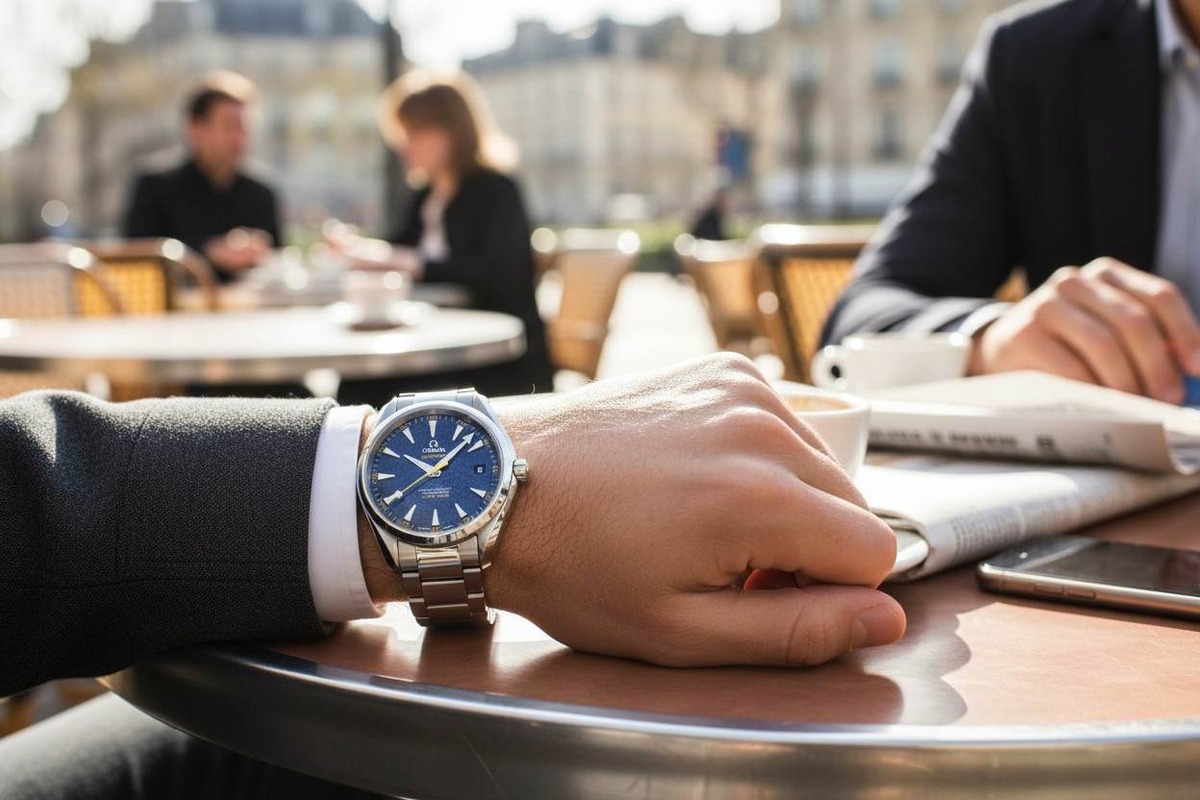What does a 5 ATM water resistance rating mean on a watch?
You see "5 ATM" marking on your watch dial and wonder what it actually means? Although it sounds technical and gives the impression of solid water protection, reality can be more complicated. Before you dive into a pool with your watch, learn the limitations and pitfalls of this popular water resistance class. This way you'll avoid costly mistakes.
"Water resistant 5 ATM" on the dial – sounds professional, but what does it actually mean?
You look at the watch dial and see "5 ATM" or "water resistant 50 m" marking. Sounds serious, looks technical, and gives confidence that this model can somehow handle water. But what exactly? This is where it gets tricky, because despite being one of the most commonly encountered classes, most users interpret it incorrectly. It seems that since it's 50 meters, you can safely dive with such a watch, right? Well, not quite.
5 ATM water resistance is not permission for diving – neither to 50 meters depth, nor to 10. It's only a laboratory test under conditions of complete immobility, which shows that the watch will withstand the pressure that theoretically exists at that depth. But only in theory. In practice, it means protection against accidental contact with water, e.g., when washing hands, taking a shower, or getting caught in rain.
So don't be fooled by the markings. 5 ATM is a level of basic resistance to moisture and splashes, not a license for water sports feats. And although it sounds technical, it doesn't mean the watch will survive everything. Quite the opposite – improper handling of such a model can quickly end its adventure with water.
Festina The Originals Chronograph 20330/5 is a sports watch with an impressive 47 mm diameter, equipped with chronograph, date display, and solid case with steel-rubber finish, perfect for active men who appreciate bold style.
Don't let water surprise you – what you can really do with a 5 ATM watch
Men's and women's sports watches with 5 ATM water resistance marking are very popular today because they combine a decent level of protection with an affordable price and large selection of models. But here's the catch – the range of capabilities of such a watch is often overestimated, and this leads to unnecessary disappointments. If you want to use the watch in everyday situations, such as washing hands, a short shower, or rain, then go ahead – 5 ATM will handle this without problems.
You can also have it on your wrist while bathing in a tub, provided you don't turn that bath into a hot sauna. However, this is not a watch for active swimming, and certainly not for diving. Although some brands allow brief submersion in water, everything depends on the build quality of the specific model and its service condition. And here's a very important thing: don't use buttons, don't manipulate the crown, don't submerge it suddenly – even if the manufacturer claims that 5 ATM is a safe level.
In short – you can have a 5 ATM watch with you in water, but not for water "exploitation." Treat it as water-resistant equipment, not waterproof without limits. Then it will really serve you longer, without unpleasant surprises under the glass.
Orient Blue Moon II Automatic RA-AG0019B10B is an elegant watch with exposed movement that captivates with classic design and 5 ATM water resistance, perfect for everyday use.
Swimming, shower, or maybe diving? Check when 5 ATM is not enough
On one hand you have a watch marked 5 ATM, on the other – vacation, pool, maybe hotel SPA. So a natural question arises: can you swim with such a watch, or maybe even dive? And unfortunately – here it's worth cooling the enthusiasm. Despite the impressive number of 50 meters, from the perspective of real water applications, this level of tightness has significant limitations.
Dynamic pressure exerted by movement underwater can be several times greater than what the watch withstands in static tests. This means that even a quick hand movement while swimming can breach the seal if you don't have the right model. What's more, a small temperature difference between water and the watch can cause so-called thermal shock, which leads to water vapor condensation under the glass.
Therefore, if you plan regular swimming, snorkeling, or water sports, 5 ATM water resistance class is simply not enough. In such cases, you need a watch with at least 10 ATM or 20 ATM, designed with such activities in mind. By choosing the appropriate tightness class, you not only protect the watch, but also avoid unpleasant situations when after a few days in water, problems with the mechanism or fogging under the glass begin.
Orient Bambino Small Seconds Automatic is a stylish watch with 40.5 mm diameter that captivates with classic design, elegant sub-seconds dial, and automatic movement made in Japan.
50 meters in theory, but not in practice – learn the pitfalls of 5 ATM water resistance
One of the biggest pitfalls related to 5 ATM water resistance marking is... its translation to meters. When you see "50 m," it's easy to assume that's exactly how deep you can dive with this watch. The problem is that this conversion applies only to laboratory tests in which the watch performs no movement. In everyday use, underwater, the watch is exposed to forces that can exceed several times what was predicted in tests. And this is exactly where most users make the biggest mistake.
Static pressure and dynamic pressure are two completely different worlds. Static is predictable and measurable under controlled conditions. Dynamic appears in reality – with hand movement, entering water, submersion for a second. This is exactly what causes a watch theoretically resistant to 50 meters depth to fog up or refuse to work after a brief submersion in a pool.
If you care about women's or men's watches matched to your lifestyle – regardless of whether you're looking for a model resistant to splashes, shower, swimming, or diving – in the online watch store WestWatches you'll find a wide selection of models with different water resistance classes. From 3 ATM models perfect for everyday use, through versatile 5 and 10 ATM, to professional diving watches – everything in one place, from proven brands and with professional parameter descriptions.
See popular articles

What was the first watch in space? Find out what astronauts wear on their wrists
Did you know that the first watch that flew into space wasn't on a human wrist, but... attached to a dog's leg? The history of timepieces in space is a fascinating story of technological rivalry, astronaut courage, and extraordinary precision that could save lives. From the Soviet Pobeda and Gagarin's Sturmanskie to the legendary Omega Speedmaster, which passed NASA's most brutal tests – each of these watches became part of space exploration history. Discover what astronauts actually wear on their wrists and why even today, in the smartwatch era, they still choose mechanical legends.

What is GMT time and how can you use this function on your watch?
Not every watch shows only one time – some can do much more. The GMT function allows you to track the time in two or even three time zones simultaneously, making it ideal for travellers, pilots and people working internationally. But before you learn how it works and what the GMT time zone actually is, it's worth learning about its history – from Greenwich, London, to modern watches with the most advanced mechanisms.

Dlaczego zmieniamy czas na zimowy w zegarkach? Tłumaczymy mechanizm i historię zmiany czasu
Dwa razy w roku cofamy lub przesuwamy wskazówki zegara, ale rzadko zastanawiasz się, po co właściwie jest zmiana czasu i dlaczego wciąż jej przestrzegamy. To nie tylko kwestia tradycji – za tym zwyczajem stoi historia, decyzje polityczne i próba lepszego wykorzystania światła dziennego. Sprawdź, jak działa mechanizm przestawienia czasu, skąd się wziął i jakie ma znaczenie dziś.

Zegarki solarne - ranking ciekawych modeli i wszystko co warto wiedzieć przed zakupem
Zegarki solarne to nowoczesne połączenie stylu i praktyczności – zasilane światłem, niezawodne i przyjazne środowisku. Dzięki wbudowanym panelom solarnym nie wymagają regularnej wymiany baterii, co czyni je wyjątkowo wygodnymi w codziennym użytkowaniu i bardziej ekologicznymi. W naszym rankingu znajdziesz modele, które wyróżniają się nie tylko atrakcyjnym designem, ale również bogatą funkcjonalnością i imponującą trwałością, idealne dla wymagających użytkowników poszukujących zegarka na lata.

Jak zmienić czas na zimowy w Casio G Shock?
Zmiana czasu potrafi zamieszać – nie tylko w głowie, ale i na nadgarstku. Jeśli nosisz G-Shocka i chcesz szybko przestawić go na czas zimowy, nie musisz zagłębiać się w instrukcje ani zgadywać, który przycisk za co odpowiada. W tym poradniku znajdziesz konkretne wskazówki, proste kroki i sprawdzone triki, które pomogą Ci bez nerwów ustawić zegarek Casio G-Shock – niezależnie od modelu, który masz.

Jak dobrać biżuterię do zegarka? Zasady, inspiracje i gotowe triki stylizacyjne
Dobranie biżuterii do zegarka to nie tylko kwestia gustu, ale przede wszystkim umiejętność stworzenia spójnej, stylowej całości. Zegarek może być subtelnym tłem dla dodatków albo główną ozdobą, wokół której budujesz cały look. Sprawdź, jak łączyć metale, wybierać bransoletki i tworzyć zestawienia, które zawsze wyglądają elegancko i nowocześnie.

Jaki zegarek na 40 urodziny wybrać? TOP 5 wyborów
Czterdzieste urodziny to wyjątkowy moment – symboliczny etap życia, w którym zegarek może stać się nie tylko praktycznym dodatkiem, ale także wyrazem stylu, statusu i osobowości. Zegarek na 40 urodziny powinien podkreślać dojrzały gust, elegancję oraz indywidualność obdarowanego – kluczowe znaczenie ma jakość, prestiż marki oraz funkcjonalność dopasowana do codziennych aktywności Poniżej przedstawiamy TOP 5 zegarków męskich na 40 urodziny dostępnych w ofercie sklepu WestWatches – zapraszamy!

Jaki zegarek kupić na dzień chłopaka? TOP 6 propozycji od West Watches
Dzień Chłopaka to świetna okazja, aby podarować coś wyjątkowego – prezent, który będzie nie tylko praktyczny, ale i symboliczny. Zegarek to zawsze trafiony wybór – elegancki, funkcjonalny i trwały. Ważne jednak, by dopasować go do stylu oraz trybu życia obdarowywanego. Czy woli klasyczną elegancję, sportowy look, a może nowoczesne technologie? Poniżej znajdziesz sześć propozycji z oferty WestWatches.pl, które sprawdzą się jako idealny prezent.

Czym jest bezel zegarka? Wyjaśniamy jego zastosowanie i zalety
Bezel to detal, który często umyka uwadze, a w rzeczywistości decyduje o funkcjonalności, stylu i bezpieczeństwie zegarka. To właśnie ten pierścień sprawia, że czasomierz staje się czymś więcej niż tylko ozdobą na nadgarstku. Dowiedz się, co to jest bezel w zegarku, jak działa i do czego możesz go wykorzystać na co dzień.











